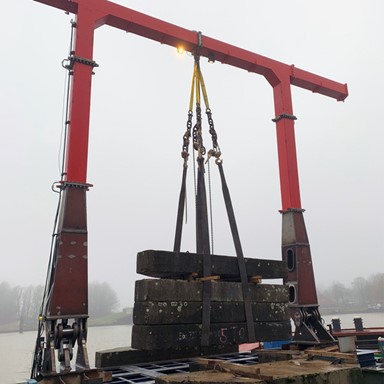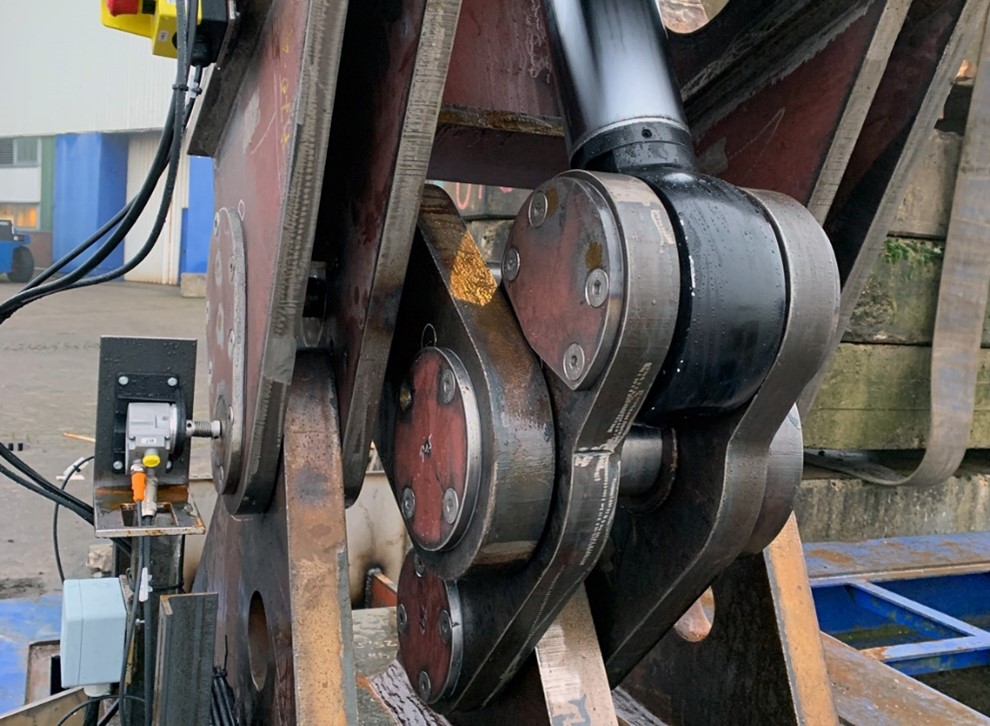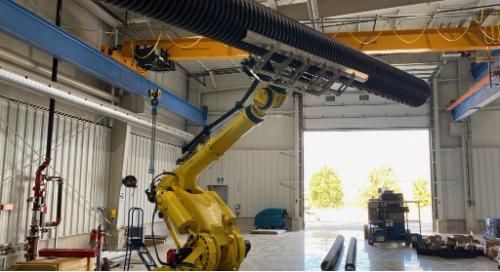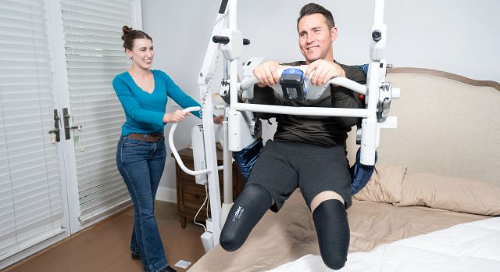Hydraulic A-Frame on Ship with Polymer Bearings Provides Maximum Freedom of Movement
The Linkage System gives the A-Frame made by Ship & Yacht Engineering a 180-degree range of motion
Founded in 2000, Ship & Yacht Engineering Limited specializes in managing and implementing complex shipbuilding and marine technology projects. Its founder and CEO, Erik Hofmann, develops everything needed in shipbuilding, from ramps to cruise ships. While working with various shipping companies, he continually became aware of the disadvantages of A-Frames. He then developed an A-Frame with maintenance-free, self-lubricating pivot kinematics for a 180-degree motion radius: the Linkage System. To minimize maintenance and keep the kinematics bearing points free of lubrication, Hofmann uses iglide® plain bearings.
Hofmann's unique A-Frame stands in the port of Leer in East Frisia. At first glance, it is not unlike traditional A-Frames. However, closer examination reveals one crucial difference. Unlike other hydraulically operated A-Frames, this one has no external cylinders. This is the great advantage of Hofmann's innovation. The lifting system is tilted with the Linkage System. The cylinders and the unique pivot kinematics are installed in the A-Frame's structure, allowing a motion radius of 180 degrees.
"Conventional A-Frames have external hydraulic cylinders that severely restrict motion radius," Hofmann explains. "This makes operations such as hooking up a heavy pulley at sea complicated and dangerous for the crew."
A rope hoist provides A-Frames with a simple mechanism but also limits their motion radius. Designing an A-Frame with the largest possible range of motion requires great effort. Distances, the height of the rope, and the hoist structure all contribute to ensuring the largest possible radius.
Suitable for up to 20 tons of pivot load
The Ship & Yacht Engineering A-Frame has already been approved by the classification society and can lift loads of up to 20 tons, depending on pivoting angle. It is now being installed on a research vessel belonging to Fugro, the world's leading geodata specialist, where it will be used to place magnetometers into the water and pull them out again.
To ensure that the pivot kinematics operates without problems on the high seas and under harsh weather conditions, Hofmann was looking for self-lubricating, maintenance-free plain bearings that were also cost-effective. He had previously used bronze bushings. However, as weather conditions constantly flushed grease out of the bearings, fresh grease must be continually applied to ensure sufficient lubrication and prevent corrosion.
Self-lubricating effect prevents a lack of lubrication
A recommendation made Hofmann aware of igus GmbH, a developer and manufacturer of self-lubricating, high-performance plastics in Cologne, Germany. The company's plain bearings made of the material iglide TX1 are now used in the A-Frame's pivot kinematics. The igus bearings minimize maintenance and require no lubrication, and have been developed explicitly for high-load applications.
"Our plain bearings incorporate a solid lubricant, enclosed in millions of tiny chambers within the material," explains Uwe Sund, Product Manager for iglide Heavy-Duty Bearings. "That way, sufficient lubricant is available to lubricate the bearing point. So, there is always lubrication." 
Since no additional lubricant is required, there is no need for manual lubrication or an automatic lubrication system. The suitable iglide plain bearing material for use in the A-Frame was already available. But the plain bearings were not - at least not in the dimensions Hofmann needed. So igus engineers manufactured bearings to Hofmann's specifications.
"My customers have fixed embarking times for their ships. So, I depend on components being available in a timely manner. Therefore, the great flexibility igus demonstrates is an important prerequisite for me," Hofmann states regarding cooperation. According to Hofmann, the plain bearing installation went smoothly. The bigger problem was the heavy sheets into which the iglide plain bearings had to be inserted.
"It was not possible to lay down the components and press in the plain bearings." Hofmann explains that the bolts also had to be installed while the structure was standing. With a little patience, he managed to overcome this obstacle and assembled the Linkage System.
Special design enables small cylinders and low differential volume
The Linkage System has other advantages besides the great range of motion since it allows the use of small cylinders that are just 1.3 meters long and have a stroke length of 700 millimeters. The cylinders are located with the pivot kinematics in the A-Frame's frame. This protects them from mechanical damage.
The A-Frame feet can be closed with bellows. This protects the entire cylinder itself from the weather. It can even be heated for use in the Arctic. A-Frames of the size of Hofmann's model typically use large, heavy, expensive cylinders. If such an external cylinder is damaged – which can easily happen in the rough conditions on board – the consequences are serious.
"If your ship is docked in Namibia and you have to replace a six-meter cylinder, high transport costs are added to the significant cost of the cylinder," says Hofmann, who speaks from experience.
Cylinder size also plays an essential role at two other points. Large cylinders require lots of hydraulic oil to function and thus have a significant differential volume. Connecting the cylinders to the vessel's hydraulic system and pumping oil into them can limit the functionality of the vessel's other systems that require hydraulics.
The cylinders in the A-Frame with the Linkage System require just 25 liters of hydraulic oil. The differential volume is so small that the A-Frame can often be easily connected to a ship's hydraulic system. Hofmann sees a wide range of potential applications for his A-Frame and its use on research vessels such as those operated by Fugro. One example is oil drilling.





